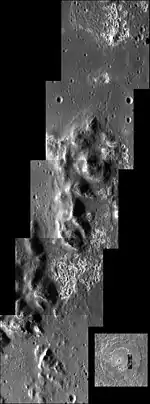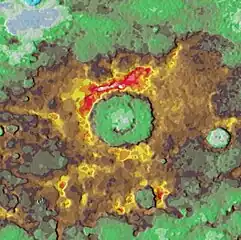Raditladi (crater)
Raditladi is a large impact crater on Mercury with a diameter of 263 km.[2] Inside its peak ring there is a system of concentric extensional troughs (graben), which are rare surface features on Mercury. The floor of Raditladi is partially covered by relatively light smooth plains, which are thought to be a product of the effusive volcanism. The troughs may also have resulted from volcanic processes under the floor of Raditladi. The basin is relatively young, probably younger than one billion years, with only a few small impact craters on its floor and with well-preserved basin walls and peak-ring structure.[3] It is one of 110 peak ring basins on Mercury.[4]
 Mosaic of MESSENGER images | |
| Planet | Mercury |
|---|---|
| Coordinates | 27.15°N 240.94°W |
| Quadrangle | Raditladi |
| Diameter | 258 km (160 mi) |
| Eponym | Leetile Disang Raditladi[1] |
Background
During its first flyby of Mercury in January 2008 MESSENGER spacecraft discovered a large impact crater approximately 2000 km west of the Caloris basin on the part of Mercury's surface previously not seen by spacecraft.[3] This crater (or basin) was subsequently (on 8 April 2008) named Raditladi after Leetile Disang Raditladi (1910–1971), a Botswanan playwright and poet.[1] Raditladi is one of the youngest features on Mercury.[5]
Geology

The central part of Raditladi is occupied by a large peak ring with a diameter of 125 km.[3] The ring is slightly offset from the geometrical center of the basin in the north-west direction.[6] The floor of Raditladi is covered by two types of terrain: light smooths plains and dark hummocky plains. The former partially embay the hummocky plains and are probably volcanic in origin. The latter are present mainly on a part of the floor between the peak ring and crater rim; they interpreted to be the original crater floor material not covered by the light colored lavas of smooth plains. The hummocky plains are slightly bluer than smooth plains. The areas outside Raditladi are covered by the dark relatively blue impact ejecta.[3] The peak ring massifs at some places expose a bright blue material identical to one on the floors of some bright Mercurian impact craters (Bright Crater Floor Deposits—BCFD).[7] BCFD in Raditladi are recognized more generally as a subset of a landform now called hollows. A confirmed dark spot is present outside the eastern peak ring of Raditladi.[8] This dark spot is associated with the hollows.
Extensional troughs
Visible on the floor of Raditladi inside the peak ring are concentric narrow troughs, formed by extension (pulling apart) of the surface. The troughs are arranged in a circular pattern approximately 70 km in diameter.[3] They are thought to be graben. The geometrical center of the system of graben coincides with the center of Raditladi and is offset form the center of the peak ring complex.[6]
Extensional troughs on Mercury are quite rare, having been seen in only a few other locations:[3]
- Rachmaninoff, which is similar in many other ways to Raditladi
- as part of Pantheon Fossae and other troughs in the Caloris basin
- on the floor of Rembrandt, a large basin discovered during MESSENGER's second Mercury flyby.
Understanding how these troughs formed in the young Raditladi basin could provide an important indicator of processes that acted relatively recently in Mercury's geologic history.[9] There are two main theories of graben formation. The first is that they represent a surface manifestation of ring dikes or cone sheets. Both types of structures form when magma from a deep reservoir intrudes into the overlying rocks along conical or cylindrical fractures. The second hypothesis holds that the graben formed as a result of the floor uplift caused by the weight of the smooths plains outside the crater.[6] Such plains are indeed present to the north and east of Raditladi, although their thickness and age are not known.[3]
Age
The relative age of any surface feature can be determined from the density of impact crater on it. The density of craters on the floor of Raditladi is about 10% of that on the plains west of Caloris. The crater density is the same on the ejecta covered plains outside the basin.[5] The smooths plains and hummocky plains also have the same crater density and therefore the same apparent age.[3] The low crater density indicates that Raditladi is much younger than Caloris—it may have formed within the last billion years,[5] whereas the age of Caloris is 3.5–3.9 billion years.[10]
The young age of Raditladi shows that the effusive volcanic activity on Mercury lasted for much longer that had been thought, possibly extending to the last billion years.[5]
Gallery
 Position of Raditladi on Mercury
Position of Raditladi on Mercury Topography of Raditladi
Topography of Raditladi Exaggerated color image of Raditladi
Exaggerated color image of Raditladi Central peak ring. Concentric troughs are visible.
Central peak ring. Concentric troughs are visible.
See also
References
- "Mercury: Raditladi". USGS. Retrieved November 29, 2009.
- Baker, David M. H.; Head, James W.; Schon, Samuel C.; Ernst, Carolyn M.; Prockter, Louise M.; Murchie, Scott L.; Denevi, Brett W.; Solomon, Sean C.; Strom, Robert G. (2011). "The transition from complex crater to peak-ring basin on Mercury: New observations from MESSENGER flyby data and constraints on basin formation models". Planetary and Space Science. 59 (15): 1932–1948. Bibcode:2011P&SS...59.1932B. doi:10.1016/j.pss.2011.05.010.
- Prockter, Louise M.; Watters, Thomas R.; Chapman, Clark R.; Denevi, B. W.; et al. (2009). "The curious case of Raditladi basin". Lunar and Planetary Science. XL: 1758. Bibcode:2009LPI....40.1758P.
- Chapman, C. R., Baker, D. M. H., Barnouin, O. S., Fassett, C. I., Marchie, S., Merline, W. J., Ostrach, L. R., Prockter, L. M., and Strom, R. G., 2018. Impact Cratering of Mercury. In Mercury: The View After MESSENGER edited by Sean C. Solomon, Larry R. Nittler, and Brian J. Anderson. Cambridge Planetary Science. Chapter 9.
- Strom, G.; Chapman, Clark R.; Merline, William J.; Solomon, SC; et al. (2008). "Mercury Cratering Record Viewed from MESSENGER's First Flyby". Science. 321 (5885): 79–81. Bibcode:2008Sci...321...79S. doi:10.1126/science.1159317. PMID 18599774.
- Head, James W.; Murchie, Scott L.; Prockter, Louise M.; Solomon, Sean C.; et al. (2009). "Evidence for intrusive activity on Mercury from the first MESSENGER flyby". Earth and Planetary Science Letters. 285: 251–262. Bibcode:2009E&PSL.285..251H. doi:10.1016/j.epsl.2009.03.008.
- Robinson, Mark S.; Murchie, Scott L.; Blewett, David T.; Domingue, DL; Hawkins Se, 3rd; Head, JW; Holsclaw, GM; McClintock, WE; et al. (2008). "Reflectance and Color Variations on Mercury: Regolith Processes and Compositional Heterogeneity". Science. 321 (5885): 66–69. Bibcode:2008Sci...321...66R. doi:10.1126/science.1160080. PMID 18599770.
- Zhiyong Xiao, Robert G. Strom, David T. Blewett, Paul K. Byrne, Sean C. Solomon, Scott L. Murchie, Ann L. Sprague, Deborah L. Domingue, Jörn Helbert, 2013. Dark spots on Mercury: A distinctive low-reflectance material and its relation to hollows. Journal of Geophysical Research Planets. doi.org/10.1002/jgre.20115
- "The Curious Case of Raditladi Basin". Johns Hopkins University Applied Physics Laboratory. 2009-03-31. Archived from the original on 2016-03-03. Retrieved 2009-10-07.
- Neukum, G.; Oberst, J.; Hoffmann, H.; Wagner, R.; et al. (2001). "Geologic evolution and cratering history of Mercury". Planetary and Space Science. 49 (14–15): 1507–21. Bibcode:2001P&SS...49.1507N. doi:10.1016/S0032-0633(01)00089-7.
Further reading
- Watters, Thomas R.; Solomon, Sean C.; Robinson, Mark S.; Head, James W.; et al. (2009). "The tectonics of Mercury: The view after MESSENGER's first flyby". Earth and Planetary Science Letters. 285 (3–4): 283–286. Bibcode:2009E&PSL.285..283W. doi:10.1016/j.epsl.2009.01.025.
- NASA Astronomy Picture of the Day: Unusual Hollows Discovered on Planet Mercury (27 March 2012)